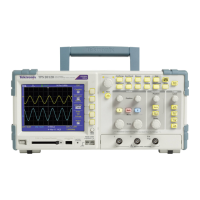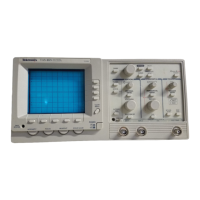
Do you have a question about the Tektronix TPS2014B and is the answer not in the manual?
| Bandwidth | 100 MHz |
|---|---|
| Channels | 4 |
| Sample Rate | 1 GS/s |
| Record Length | 10 kpts |
| Vertical Resolution | 8 bits |
| Timebase Range | 5 ns/div to 50 s/div |
| Power Source | Battery or AC Adapter |
| Display | Color LCD |
| Display Type | Color LCD |
| Display Size | 7 in. |
| Trigger Modes | Auto, Normal, Single |
| Trigger Types | Edge, Pulse Width, Video |
| Connectivity | USB |
| Power Supply | 100-240 V AC |
| Input Impedance | 1 MΩ |
Precautions for using probes and test leads, including voltage ratings and safe handling.
Safety procedures for performing service on the product by qualified personnel.
Definitions of terms and symbols used in the manual for clarity.
Procedures for taking measurements without a common ground reference using isolated channels.
Steps to install and set up the oscilloscope, including power connection.
Information on oscilloscope battery pack capacity, usage, and charging methods.
Information about compatible probes, their usage, and critical safety precautions.
Procedures for checking, compensating, and adjusting voltage probes for accuracy.
Scaling current probes and performing oscilloscope self-calibration.
Description of the oscilloscope's display area and the information displayed.
How to navigate and use the oscilloscope's menu system for functions.
Explanation of controls for vertical waveform positioning and scaling.
Explanation of controls for horizontal waveform positioning and scaling.
Overview of trigger controls and front-panel menu buttons.
Description of input connectors and other front-panel items like CF card slot.
Basic setup functions like Autoset, Autorange, saving, and recalling.
How triggers determine waveform acquisition and display stability.
Acquiring signals, understanding acquisition modes, and scaling waveforms.
Explanation of aliasing and how to avoid it in time-domain analysis.
Taking simple measurements, automatic measurements, and analyzing two signals.
Analyzing differential signals, power waveforms, and using cursors.
Measuring pulse width, rise time, and analyzing noisy signals.
Triggering on specific widths/videos and using window function for details.
Setting up the time-domain waveform and displaying the FFT spectrum.
Choosing FFT window types and analyzing the FFT spectrum.
Setting acquisition parameters and using Autoset/Autorange for signal display.
Configuring waveform display, using cursors, and horizontal controls.
Accessing automatic measurements, printing, and utility functions.
Adjusting probe compensation and listing standard/optional accessories.
Electrical/environmental specifications, performance graphs, and safety summary for probes.
Electrical specifications for inputs, triggers, and vertical measurements.
Horizontal specifications and general electrical, environmental, and mechanical details.
Lists of standard/optional accessories, power cords, and available manuals.
Guidelines for storing, caring for, and cleaning the oscilloscope and probes.
Description of the oscilloscope's default settings and what they are reset to.
Maximum voltage ratings for passive, differential probes, and preamplifiers.











